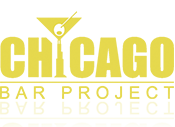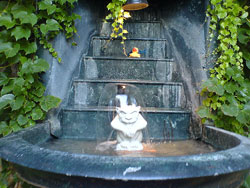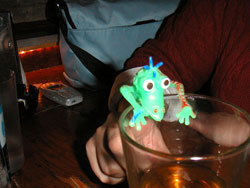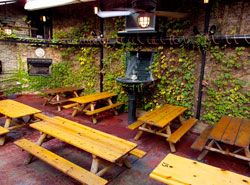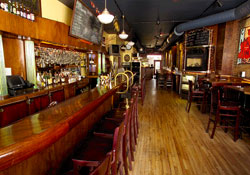“Chicago’s Premier Neighborhood Tavern”
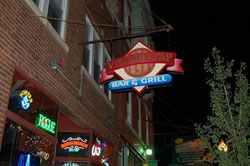
Photo courtesy of Danielle Altshuler WileyWhen you think of classic Chicago bars, you may think of a yuppie joint in Lincoln Park, a trendy tavern in Bucktown or Wicker Park, a swanky lounge in River North, or your favorite sports bar in Wrigleyville. Few may consider anyplace in or around Roscoe Village. But here, in “The Village,” lies one of the best bars in the city: the Village Tap. What makes a bar one of the best? To my mind, it means that a bar has been successful in creating an inviting atmosphere that makes you want to come back again and again. The Tap has achieved this level of bar-hood by offering good pub grub, an impressive variety of beer, an excellent beer garden, and a laid-back oasis for all.
Roscoe Village itself is a neighborhood enclave within Lakeview, similar to that of Wrigleyville to the immediate northeast. While not everyone agrees, Roscoe Village is most commonly associated as lying between Ashland to the east, Western to the west, Roscoe to the north, and Belmont to the south. Roscoe Village is not very big, and its main strip is even smaller. To find it, take Roscoe between Damen and Hoyne. There, a modest brick building with a wooden sign hanging above the door houses the Village Tap, right next to the Village Discount Outlet and across the street from El Tinajon Fine Guatemalan Cuisine. At night, the bar can be seen by its Tabasco-like “Village Tap” neon sign, just behind the large tree with green string lights next to the bike rack (ala O’Donovan’s).
Upon entering the Tap, you’ll find one of Chicago’s classic barroom layouts: a long, worn wooden bar with green and red beveled lights behind it, a worn hardwood floor and a high ceiling. If you can’t find a seat at the bar, grab one of the wooden tables that run along the west side of the room. Here, you can have a go on one of the Tap’s many board games, browse through the Chicago Reader (a stack of which can be found up front), enjoy some of the Tap’s fine pub grub, or take some of the local artwork hanging above the tables and illuminated by track lights (the “exhibits” change monthly). There is also a Golden Tee (surprise), an old wooden phone booth by the cigarette machine, a Ms. Pac Man arcade game, and few televisions are spread around the room so that you can watch the desperation of your favorite Chicago sports team.
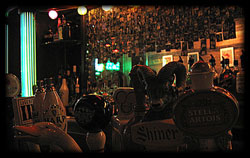
Photo courtesy of Anna LisaUnfortunately, the tables are very narrow and have barely any space between them, so be prepared as there is always some yahoo brushing past or up against you. My recommendation: when the weather is warm, head out to the beer garden in the back. If it’s cold and the Tap is crowded, and you’re feeling adventurous, head to the nearby, not-as-inviting Mulligan’s at Roscoe and Damen or the new Riverview Tavern (formerly “red” and “The Damen“). Otherwise, additional seating can be found between the plants in front of the large plate glass windows, on either side of the front door. It was at one of these seats where my enjoyment of a pint was pleasantly interrupted by a group of Scottish bagpipers. They serenaded the room with a few songs and then passed out Scottish berets with fake orange hair coming out from under them, to promote one of the Scottish beers on tap at the Tap.
If it were larger, I would rate the Village Tap’s beer garden as one of the best in the city. The brick walls are covered with ivy and the retractable roof ensures that the beer garden is open all year round. A variety of wooden picnic tables allow you to take a load off. To maximize seating, those at the Village Tap removed the leaky fish pond, but it’s still can be hard to find a seat. While this is a shame, a similar environment can still be found in John Barleycorn’s beer garden on Lincoln Avenue. In the summer, the Tap’s beer garden is the place to be any night of the week (if you can get a table). If you like the Village Tap’s beer garden, I suggest you also try the ones found at Resi’s Bierstube, Charlie’s Ale House and the Schubert Inn. While the Village Tap’s beer garden is “heated” when it’s cold outside because of the retractable roof and plastic insulation, the heat lamps can’t quite keep out the Chicago winter and the fireplace only provides heat for the single picnic table in front of it. I once froze through a meal out there in February when all the tables inside were full and the group in front of the fireplace was firmly camped for the night. It took at least an hour at nearby (now defunct) Grizzly’s Lodge to warm up afterwards.
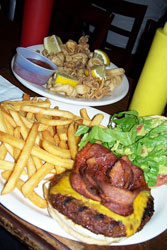
Photo courtesy of Joe M500Food at the Village Tap primarily consists of fairly traditional pub fare with a somewhat Cajun theme. The Tap’s specialties include a good variety of sandwiches, quesadillas, humus and falafel, and a few vegetarian dishes that includes chili and a mean veggie burger. A word on the gumbo: decent taste but way too much celery and okra. There is no waitress service at the Tap, so grab a menu and order from the counter located under the neon “Café” sign, just after the Golden Tee, the Ms. Pacman machine and the $3 photo booth, and just before the entrance to the beer garden in the very back of the Tap’s front room. Busboys bring out your food according to the number at your table. If that doesn’t float your boat, head to nearby Kitsch’n on Roscoe for eclectic retro cuisine, Costello’s for tasty sub sandwiches, or even Starbucks for a raspberry scone (used to be a motorcycle-themed bar called “Ace”).
For me, the beer selection is more notable than the food, with over 30 ales on tap and more in bottles. The Village Tap rotates the brewskies they offer on tap, so check out the large chalkboard above the bar for current selections. Like Quenchers, the Map Room and Hopleaf Bar, the Village Tap, having opened in 1990, was one of the first bars to offer patrons an alternative to the Budweiser–Heineken–Miller conundrum. As many bars have followed-suit, this is less of a notable distinction today for the bar, but patrons can be satisfied in knowing that the Village Tap was a pioneer in this area and helped facilitate wider beer selections being available at most other bars throughout the city. However, daily microbrew specials featuring $4 pints and $14 pitchers continue to pack ’em in. When it’s time for you to leave this blessed establishment, have a look above the door. There, you’ll notice an old barrel with a tap protruding from its side. Perhaps this was the original “village tap.”
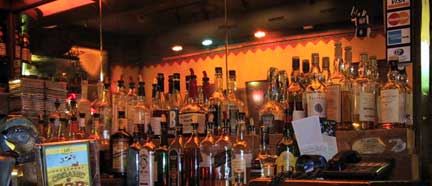
The crowd at the Tap is a mix of local yuppies, hip locals [read: artsy-artsy types], softball players (sponsored by the Tap), and older neighborhood residents. As strange as it may seem, the combination works: the Tap has a great atmosphere for hanging out and doing whatever. The only problem I have with the Tap is that, like brethren pub Sheffield’s, the Village Tap suffers from over-popularity: it is difficult to find anywhere to sit at the Tap except for nights early in the week and during the day. While I often recommend that people try the Tap, I also tell them that if it’s too crowded, head over to the Four Moon Tavern or Riverview Tavern instead, both just a few blocks east on Roscoe.
“Roscoe Village’s social hub has transcended the neighborhood bar tag and advanced to the next level: destination. Word has spread, but the invading weekend throngs have yet to destroy the Tap’s warm bar-and-grill charm. The 30-brew draft selection is fearless, the beer garden is peerless, and patrons sneerless. Great local art on the walls.”
– Chicago Magazine (January 1999)Overall, the Village Tap is a classic Chicago neighborhood bar, in the same league as Gannon’s Pub in North Center, Toons on Southport, and sister pub Jak’s Tap in Greektown. While the beer garden is the only individual feature that really stands out about the Tap, it’s a great bar nonetheless because of all the little things making it easy to want to become a regular. “About as good as it gets, so don’t tell anyone,” is the summary from The Official Chicago Bar Guide (1994). I couldn’t agree more. For more information, check out the Village Tap website. Cheers to the Tap!
[back to the Chicago Bar Project]
